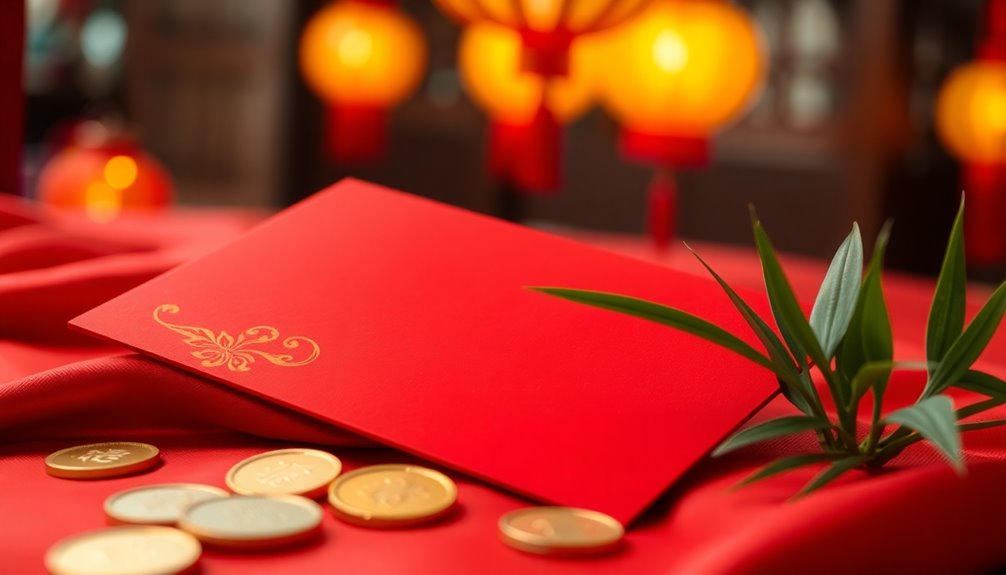The lucky number on red envelopes is eight, which symbolizes wealth and prosperity in traditional Chinese culture. When you gift red envelopes during celebrations like Lunar New Year or weddings, choosing amounts involving this number brings good fortune. You should also avoid the number four, as it's associated with misfortune. Using crisp, new bills and presenting the envelope with both hands is part of the etiquette that enhances this meaningful tradition. As you explore this beautiful practice further, you'll discover more about its rich history and contemporary adaptations that keep it alive in today's world.
Key Takeaways
- The number 8 is considered the luckiest number for red envelopes, symbolizing wealth and prosperity.
- The number 4 is avoided as it represents death and is seen as unlucky in Chinese culture.
- Even numbers are preferred for balance, while odd numbers are associated with funerals and should be used cautiously.
- Ideal amounts for children typically range from 50 to 200 yuan, while amounts for elders range from 500 to 2,000 yuan.
- Crisp, new bills are essential for red envelopes, as old or dirty notes are viewed as disrespectful.
Origin of Red Envelope Tradition
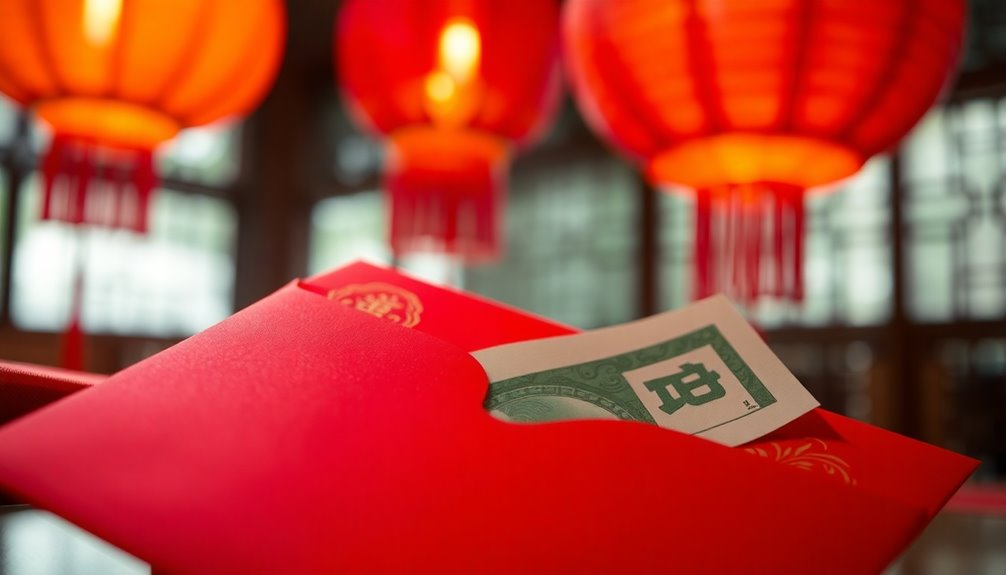
The tradition of red envelopes, or "hongbao," traces its roots back to ancient Chinese legends, particularly a tale about a demon named Sui who terrorized children on New Year's Eve.
To protect their kids, parents began giving them eight coins wrapped in red paper, believing these red envelopes would ward off the demon and bring good luck.
Over time, this tradition of giving evolved into a symbol of safety and prosperity, especially during the Lunar New Year and weddings.
Today, you'll find married individuals gifting red envelopes filled with money inside to unmarried children and younger relatives.
The vibrant red color represents happiness and prosperity, making red envelopes a cherished aspect of various celebrations across Asian cultures.
Significance of Lucky Numbers
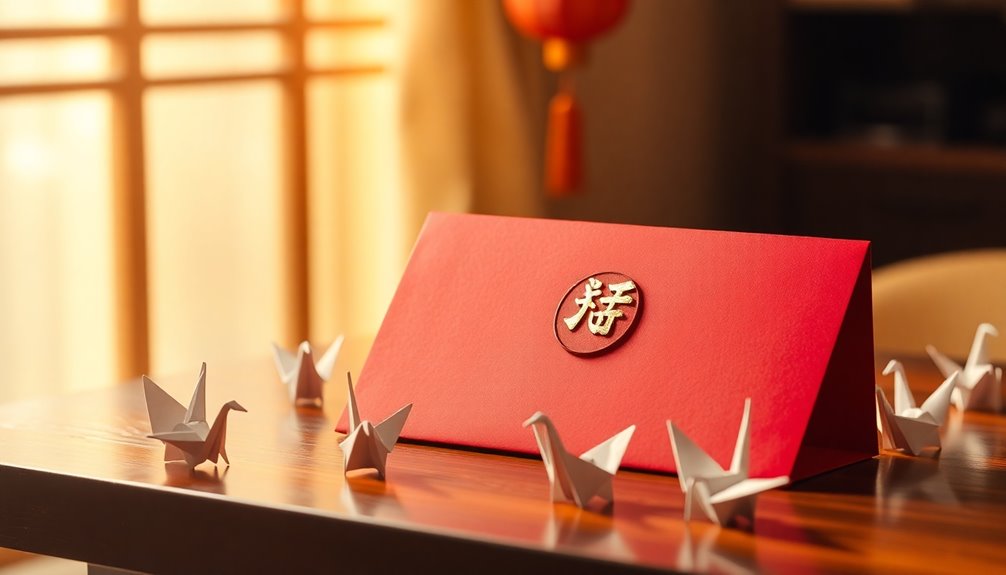
In Chinese culture, the numbers you choose for red envelopes can really impact the message you send.
While the number 8 brings wishes of wealth and prosperity, you'll want to steer clear of the number 4, as it's linked to bad luck.
Understanding these preferences helps you honor traditions and spread good fortune during celebrations.
Numbers to Avoid
Avoiding certain numbers when giving red envelopes is essential to ensuring good fortune. The number 4, for instance, is a big no-no as it sounds like "death," inviting bad luck. Instead, you'll want to focus on even amounts, which symbolize balance and harmony. Odd amounts, on the other hand, are linked to funerals and are generally seen as less auspicious.
Here's a quick reference for numbers to avoid:
| Number | Meaning | Impact |
|---|---|---|
| 4 | Death | Bad Luck |
| 1 | Loneliness | Unfavorable |
| 3 | Birth (associated) | Mixed Luck |
| 5 | Unstable | Bad Luck |
| 7 | Separation | Unfavorable |
Steer clear of these to maintain positive energy!
Favored Numbers for Prosperity
When choosing numbers for red envelopes, certain digits stand out for their positive connotations and ability to attract prosperity. The number 8 is particularly favored, symbolizing wealth and abundance in Chinese culture, making it a popular choice for lucky money.
You might also consider the number 6, which represents smooth progress, as another good option. Generally, even numbers are preferred over odd ones since they embody balance and harmony, reinforcing positive intentions.
It's important to remember that the amount you choose can reflect your relationship with the recipient; larger sums often indicate closer connections. Additionally, some studies suggest that infidelity trends may influence emotional stability, which can impact how people perceive and engage in cultural traditions like giving red envelopes.
Avoid numbers like 4, as their association with death makes them inauspicious. Embrace these lucky numbers to enhance the spirit of giving!
Common Practices for Giving
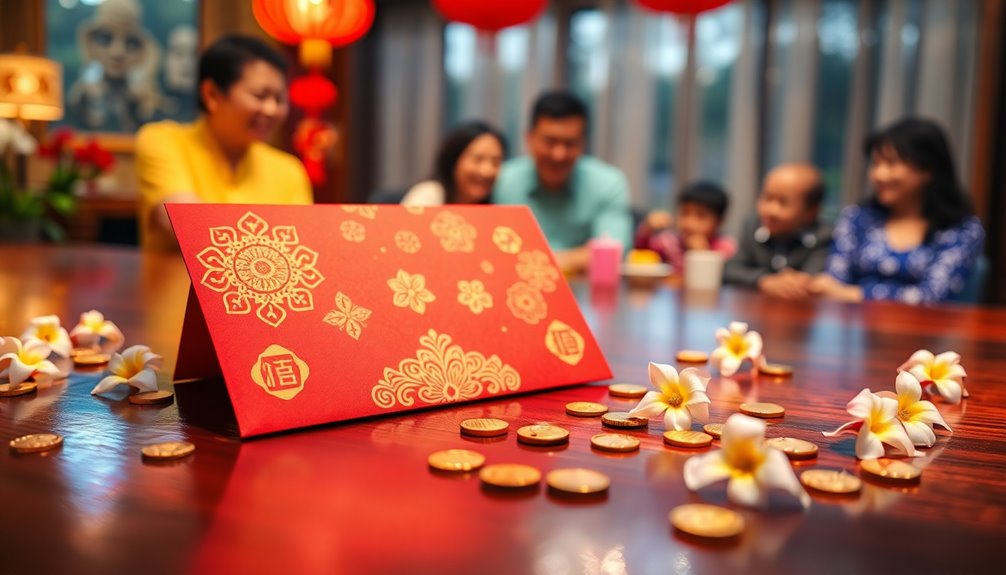
To guarantee your red envelope gift is well-received, it's important to follow certain customs that reflect respect and good intentions.
Here are some common practices for giving red envelopes:
- Use crisp, new bills to symbolize good luck and respect.
- Avoid the number 4 in the amount of money, as it's considered unlucky.
- Present the envelope with both hands, emphasizing the importance of family members and relationships.
- Wish the recipient well verbally, enhancing the spirit of the tradition.
Ideal Amounts for Red Envelopes
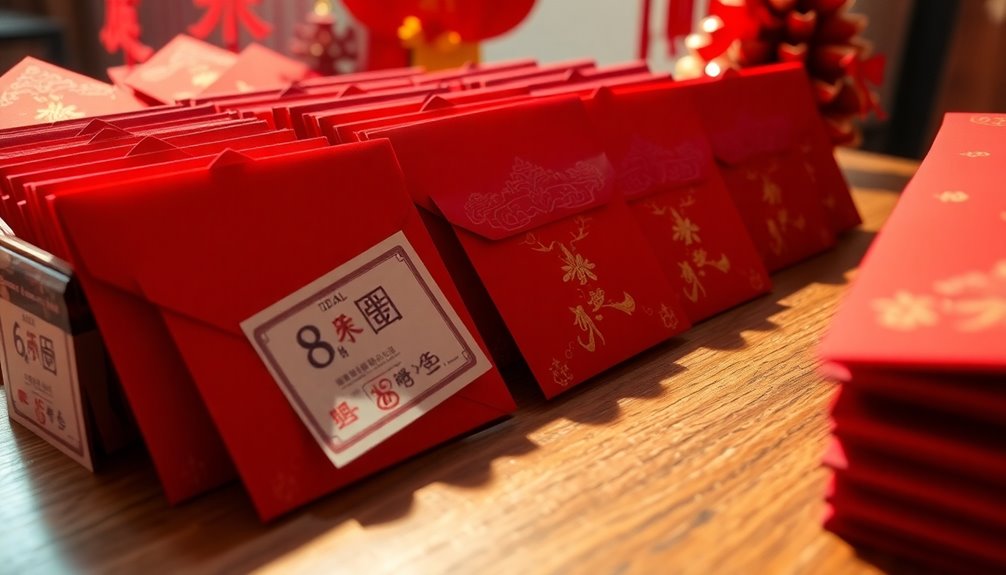
Choosing the right amount for red envelopes can enhance the gesture's significance and guarantee it aligns with cultural expectations.
To bring good luck and symbolize happiness and prosperity, you should consider certain ideal amounts. For children, amounts typically range from 50 to 200 yuan ($10 to $30), while for elders, you might opt for 500 to 2,000 yuan ($100 to $300).
It's crucial to avoid the number 4, associated with bad luck, and favor the number 8 instead. Always use crisp, new bills, as old or dirty notes are seen as disrespectful.
Distinct envelope designs for different denominations also help avoid confusion, ensuring your gift of money conveys the right message and sentiment.
Cultural Variations in Customs
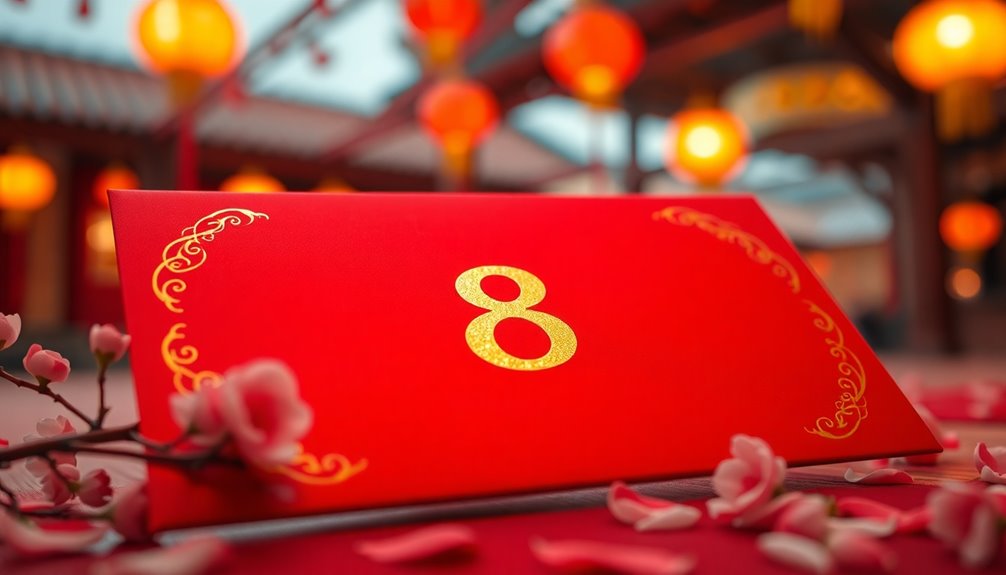
When you explore red envelope customs, you'll notice how practices vary across regions and cultures.
For instance, while the number 8 is celebrated for its prosperity, the number 4 is often shunned due to its unlucky connotation.
These differences highlight the rich tapestry of traditions surrounding this beloved practice.
Regional Practices Differences
Although the tradition of giving red envelopes is widely recognized, the practices surrounding them can vary greatly from region to region. Here are some key regional practices you might find interesting:
- In Northern China, larger sums are typical, while Southern China often favors smaller amounts.
- Hong Kong couples give two red envelopes, whereas married couples in Taiwan usually present one together.
- Vietnamese customs, known as li xi, often tie amounts to age and relationship, emphasizing family during Tet.
- The design of red envelopes can also differ, with local symbols reflecting unique traditions.
These variations not only highlight the significance of good luck associated with money in a red envelope but also reveal the rich cultural tapestry surrounding this cherished custom.
Symbolic Numbers in Cultures
Many cultures attach significant meanings to numbers, shaping how gifts are given and received.
In many Asian societies, the number 8 is a favorite for red envelopes, symbolizing good luck and prosperity due to its phonetic resemblance to wealth. Conversely, the number 4 is often shunned, as it sounds like death, invoking superstitions that discourage its use in monetary gifts.
Vietnamese culture also favors even numbers in the practice of giving li xi, avoiding those tied to misfortune. Notably, the number 6 represents a smooth path in life and is deemed lucky, while some parts of China view the number 9 as auspicious, representing long-lasting prosperity.
Understanding these symbolic numbers enriches your gift-giving experience.
Recipients of Red Envelopes
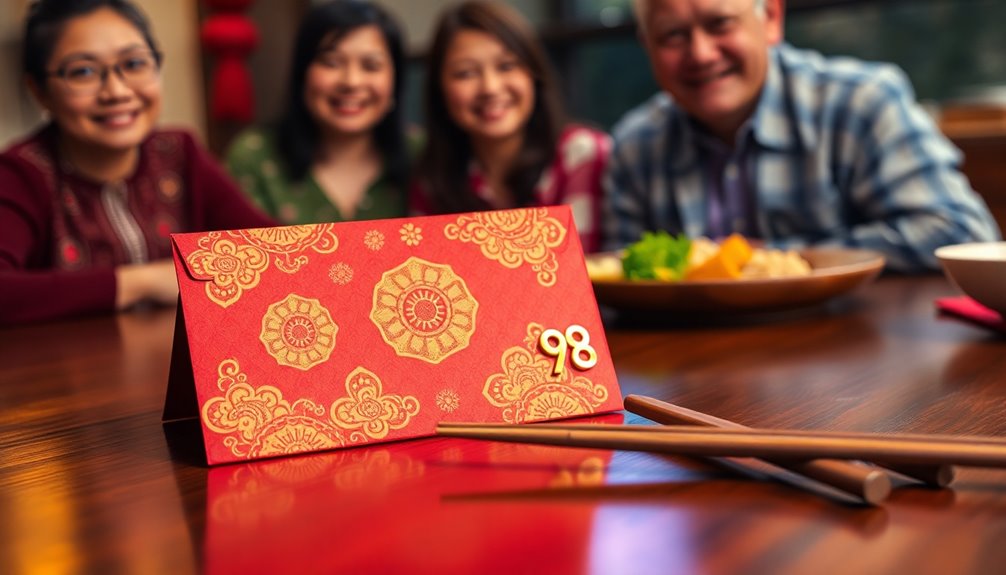
Unmarried children are the primary recipients of red envelopes during Chinese New Year, as these gifts symbolize blessings and good fortune.
Typically, parents and grandparents give these red envelopes to younger, unmarried relatives, reinforcing familial bonds. You might also receive red envelopes from close friends and neighbors, especially if they've children.
Here's what makes red envelopes special:
- They represent good luck and blessings.
- They strengthen family and community ties.
- Giving is a sign of respect.
- There's no obligation if you're not present.
Etiquette for Receiving Envelopes
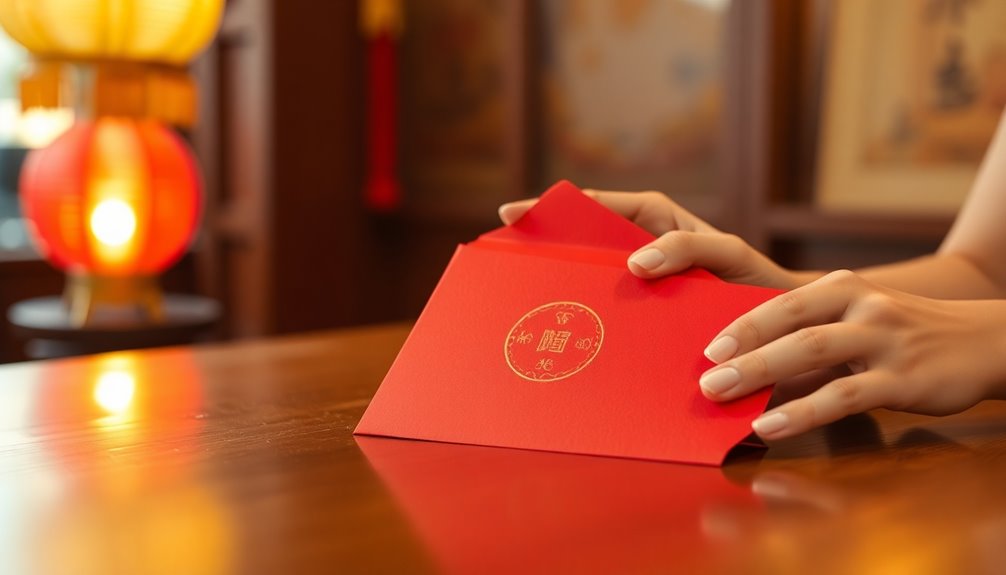
When receiving a red envelope, it's important to follow specific etiquette to show respect and appreciation for the giver. Always accept the envelope with both hands; this gesture conveys gratitude and respect.
After receiving, express your thanks verbally to enhance the goodwill of the moment. It's considered inappropriate to open the envelope in front of the giver, so wait until you're alone to maintain modesty.
Additionally, greeting the giver with auspicious phrases, like "Gōng Xǐ Fā Cái," can convey good luck and positive intentions.
If you can't attend an occasion where red envelopes are exchanged, remember there's no obligation to give or receive them, respecting the spirit of the tradition.
Modern Adaptations of Tradition
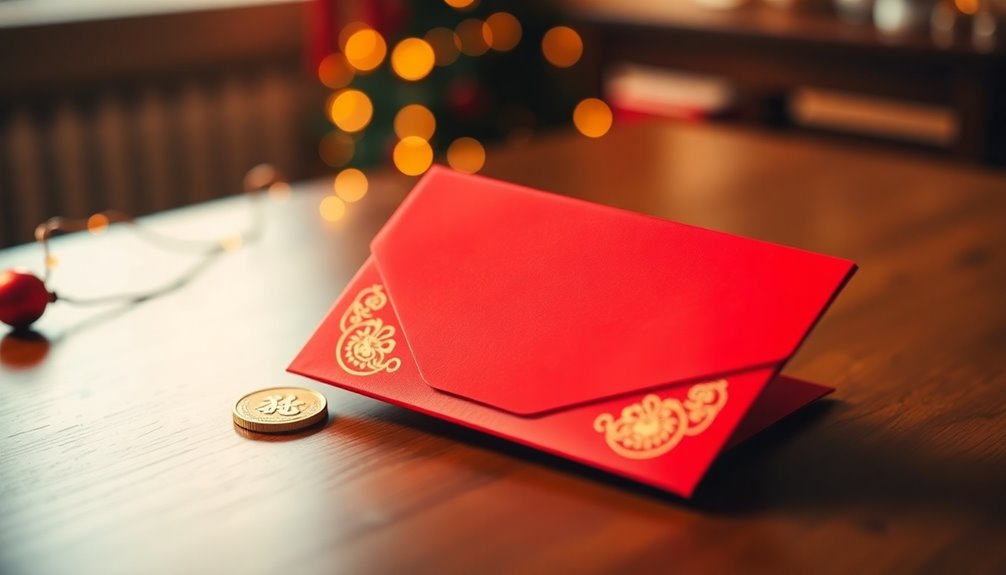
As technology evolves, so does the way you can participate in the cherished tradition of giving and receiving red envelopes. The modern adaptations of this practice are exciting, especially for the younger generation.
Here are some popular trends you might consider:
- Digital Red Envelopes: Use apps like WeChat for instant sharing of blessings and money.
- Personalized Designs: Create unique envelopes with custom messages and aesthetics to reflect your style.
- Eco-friendly Options: Choose red envelopes made from recycled materials to address environmental concerns.
- Social Media Sharing: Showcase your red envelope exchanges online, celebrating your connections during festive occasions.
These adaptations not only keep the tradition alive but also make it relevant for today's celebrations.
Crafting Your Own Red Envelopes
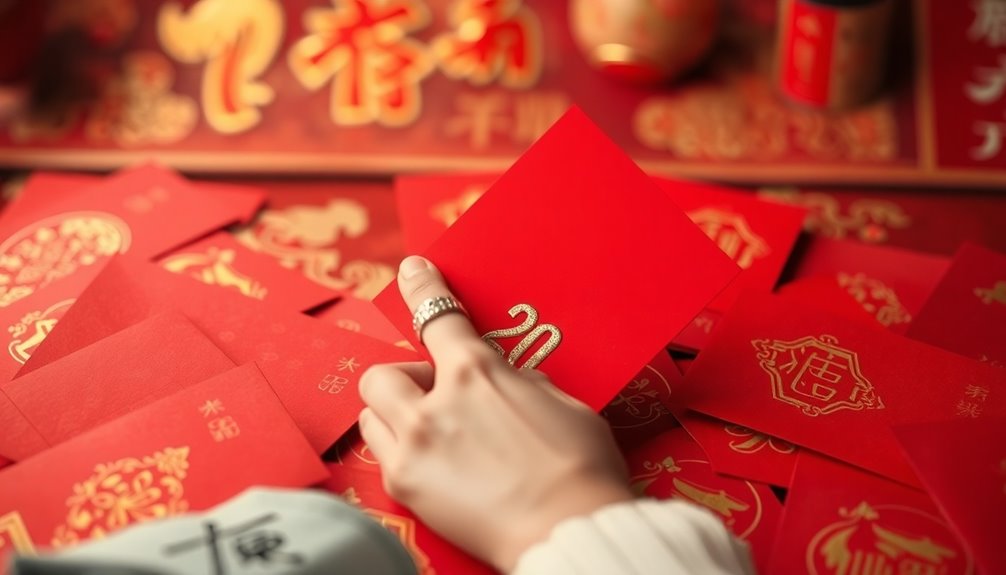
Crafting your own red envelopes can be a delightful way to engage with tradition while expressing your creativity. Start with a square piece of red paper, ideally 8 inches, and follow the folding techniques to form your envelope. After folding the corners to the center, tuck the top triangle for stability. Add gold symbols for good luck and personalize your creation.
Here's a table to inspire your crafting journey:
| Aspect | Significance |
|---|---|
| Color | Represents good luck |
| Shape | Symbol of prosperity |
| Number of Envelopes | Use odd numbers for blessings |
| Decorations | Enhances cultural appeal |
| Purpose | Gifts for celebrations |
Fill your envelopes with cash or gifts, and seal them with tape or a gold seal for a special touch!
Frequently Asked Questions
What Is the Lucky Number for Red Envelope?
If you're wondering about the lucky number for red envelopes, it's generally the number 8. This number symbolizes prosperity and good fortune in Chinese culture, making it a popular choice for monetary gifts.
You'll want to avoid the number 4, as it's linked to bad luck and death.
When giving a red envelope, consider using even amounts, as they enhance the auspiciousness and convey positive intentions to the recipient.
How Much Money Should I Put in a Red Envelope?
Choosing how much to put in a red envelope is like picking the perfect gift.
If you're giving to children, consider amounts between 50 and 200 yuan, while elders might appreciate 500 to 2,000 yuan.
For acquaintances or friends' kids, 20 to 50 yuan works well.
What Is the Lucky Envelope Tradition?
The lucky envelope tradition, known as "hongbao," involves giving red envelopes filled with money during important events like Lunar New Year or weddings.
You typically receive these envelopes from married individuals, and they symbolize good fortune and prosperity.
The envelopes are often decorated in gold and should contain crisp, new bills to enhance their significance.
Avoid using worn currency or coins, as they're considered inauspicious.
This tradition brings joy and blessings to the recipients.
What Are the Lucky Hongbao Numbers?
When it comes to lucky numbers for hongbao, you'll want to steer clear of the number 4, as it's often linked to misfortune.
Instead, embrace the charm of the number 8, which symbolizes prosperity.
Even numbers generally shine brighter, while amounts like 168 yuan are a delightful choice, echoing wishes for smooth sailing and wealth.
Choosing the right amount can sprinkle a little extra joy into your celebrations!
Conclusion
To sum up, embracing the enchanting essence of red envelopes can deepen your connection to tradition. By understanding the significance of lucky numbers and following the customs of giving and receiving, you'll not only spread joy but also create meaningful memories. Whether you're crafting your own or choosing the perfect amount, these vibrant tokens of good fortune foster friendship and fortune. So, celebrate the spirit of this stunning tradition and share the luck with loved ones today!
